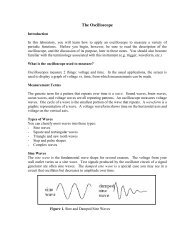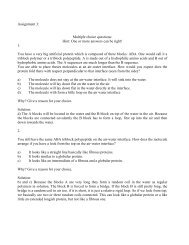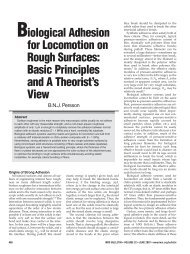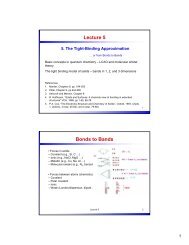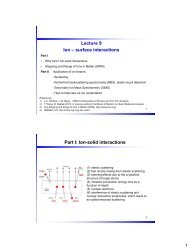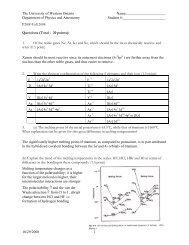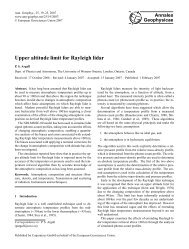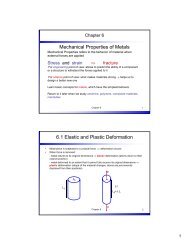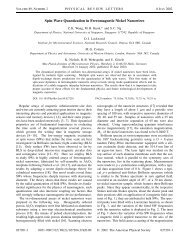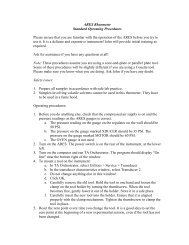Adsorption, desorption, diffusion
Adsorption, desorption, diffusion
Adsorption, desorption, diffusion
- No tags were found...
Create successful ePaper yourself
Turn your PDF publications into a flip-book with our unique Google optimized e-Paper software.
Physics 9826bLecture 5Selected aspects of thermodynamics foradsorption, <strong>diffusion</strong> and <strong>desorption</strong>PhysisorptionChemisorptionSurface BondingMechanisms of adsorption/<strong>diffusion</strong>/<strong>desorption</strong>References:1) Zangwill, Chapter 8, 9, 142) Attard and Barnes, p.1-17, 27-34, 71-753) Woodruff & Delchar, Chapter 5, p.3564) Kolasinski, Chapter 3 and 45) Somorjai, Chapter 3.8, 4, 51Force and Energy DiagramF net = F attactive + F repulvise( Z1e)(Z2e)FATTR 24oanbFREP n1an and b are constants; n 7 9FNETn 9;Z Z ebn21 20 2 n14oaa2Z1Z2e9b ;2 104oaa2 8Z1Z2eab 49o1362Z1Z2eao82Lecture 5, January 28, 2013 1
Physics 9826b5.1 Basics of Collision Process(a) Elastic Scattering(b) Inelastic ScatteringAdsorb(c) Chemisorption(d) PhysisorptionSurface <strong>diffusion</strong>Surface reactionDesorptionCf. Kolasinski Lecture 6 3Physisorption vs ChemisorptionChemisorptionElectron exchangeChemical bond formationStrong> 1eV (100 kJ mol -1 )Highly corrugated potentialAnalogies with coordinationchemistrySecond phase can formfor suitable T and PPhysisorptionPolarizationVan der Waals attractionsWeak< 0.3 eV (30kJ mol -1 )Stable only at cryogenictemperatures (N 2 77K, He 4K)Less strongly directionalMultilayers can formO/Fe, Al, SiH/PdNH 3 /CuH 2 / Fe, AuH 2 O/AuNH x /Cu4Lecture 5, January 28, 2013 2
Physics 9826b5.2 Binding Sites and DiffusionThe binding energy of an adsobate depends on its position on the surface, oron the binding site5Binding Sites and Diffusion<strong>Adsorption</strong> sites separated by energetic barriers• can be thought of <strong>diffusion</strong> barriersEffects of T on <strong>diffusion</strong>:Diffusion rate in a system will increase withtemperature:D D eoEARTD – diffusivity, m 2 /sD 0- proportionality constant, m 2 /s, independent of TE A – activation energy for diffusing species, J/molR – molar gas constant; R = 8.314 J mol-1 K-16Lecture 5, January 28, 2013 3
Physics 9826bFick’s first law of <strong>diffusion</strong>dCJ Ddx atoms mJ D2 m s s‘-’ sign: flux direction isfrom the higher to the lowerconcentration; i.e. it is theopposite to theconcentration gradient2For steady-state <strong>diffusion</strong> condition (no change inthe system with time), the net flow of atoms isequal to the diffusivity D times the <strong>diffusion</strong>gradient dC/dx dC atoms 1 3 dx m m Diffusivity D depends on:1. Diffusion mechanism2. Temperature of <strong>diffusion</strong>3. Type of crystal structure (bcc > fcc)4. Crystal imperfections5. Concentration of diffusing species7Non-Steady-State DiffusionIn practice the concentration of solute atoms at anypoint in the material changes with time – non-steadystate<strong>diffusion</strong>For non-steady-state condition, <strong>diffusion</strong>coefficient, D - NOT dependent on time:Second Fick’s law of <strong>diffusion</strong>:If D D(x), in 1D case:In 3D case:dC xdtdC xdtdCdtx2 C D2xd dCx Ddx dxThe rate of compositional change is equalto the diffusivity times the rate of thechange of the concentration gradient2 2 2 C C C D 2 2 xyz2Change in concentration in 2 semi-infiniterods of Cu and Ni caused by <strong>diffusion</strong>, FromG. Gottstein “Physical Foundations ofMaterial Science”8Lecture 5, January 28, 2013 4
Physics 9826bNon-Steady-State Diffusion (continued)With specific initial or boundary conditions this partial differential equations canbe solved to give the concentration as function of spatial position and timec(x, y, z, t)Let us consider two rods with different concentrations c 1and c 2 which are joined at x=0 and both are so long thatmathematically they can be considered as infinitely longThe concentration profile at t = 0 is discontinuous at x = 0:x < 0, c = c 1 ; x < 0, c = c 2We can obtain solution of:cc(x,t) c where erf ( z)12 c212z02dC x C D2dt xxDtee22cd2 c21 1erf 2x Dtd,is known as theerror functionxz 2 Dt9Gas <strong>diffusion</strong> into a solidLet us consider the case of a gas A diffusing into a solid BElementASolid BCs CC CSxo x erf 2 Dt x = 0C S – surf. C of element in gas diffusing into thesurfaceC o – initial uniform concentration of element insolidx - distance from surfaceD – diffusivity of diffusing solute elementt – timeerf – mathematical function called error function10Lecture 5, January 28, 2013 5
Physics 9826bError functionCurve of the error function erf (z) forz 2xDtLecture 6 11Example…If boron is diffused into a thick slice of Si with no previous Bin it at T=1100°C for5 h, what is the depth below the surface at which the concentration is 10 17atoms/cm 3 if the surface concentration is 10 18 atoms/cm 3 ? D = 4 × 10 -13 cm 2 /sfor B diffusing in Si at 1100°C.Lecture 5 12Lecture 5, January 28, 2013 6
Physics 9826bAtomistics of Solid State Diffusion• Diffusion mechanisms:1. Vacancy (substitutional) <strong>diffusion</strong> – migration of atom in a lattice assistedby the presence of vacanciesEx.: self <strong>diffusion</strong> of Cu atoms in Cu crystal2. Interstitial <strong>diffusion</strong> – movement of atoms from one interstitial site toanother neighboring interstitial site without permanent displacement any ofthe atoms in the matrix crystal latticeEx.: C <strong>diffusion</strong> in BCC iron13Vacancy (Substitutional) Diffusion MechanismSubstitutional (in homogeneous system - self-<strong>diffusion</strong>,in heterogeneous system – solid state solutions)• Vacancies are always present at any T• As T increases # of vacancies increases <strong>diffusion</strong> rate increases• Move atom A (from (1) to (2)) = move vacancy from(2) to (1)..?higher T melt stronger bonding between atoms high activation energy to move V14Lecture 5, January 28, 2013 7
Physics 9826bEhrlich-Schwoebel Barrier, E SExchange mechanism of <strong>diffusion</strong>(important for metal-on-metal growth)STM image of chromiumdecorated steps of Cu(111)www.omicron.de15Possible mechanisms of self-<strong>diffusion</strong> and theiractivation energy1. Neighboring atoms exchange sites2. Ring mechanism3. Vacancy mechanism4. Direct interstitial mechanism5. Indirect interstitial mechanismMigration Formation Total1 8 eV - 8 eV3 1 eV 1 eV 2 eV4 0.6 eV 3.4 eV 4 eV6 0.2 eV 3.4 eV 3.6 eV16Lecture 5, January 28, 2013 8
Physics 9826b5.3 PhysisoptionPhysisorption arises from dispersion forcesd+d-rEd+d-C ;rwhere C f (Instantaneous fluctuations in chargedistribution interact with instanteneousdipole moments in neighboring species, )ATTRa6 i iThe 6-12 Lennard-Jones potential is commonly used to describe both Van derWaals and steeply rising repulsive interaction potential E 4 r 126 r 12 6r D C E Ndvr rV substrate dv i17Physisorption energy of Xe on a metal surfaceLecture 6 18Lecture 5, January 28, 2013 9
Physics 9826b5.4 Nondissociative Chemisorption• Sequential filling of binding sitesatopbridgehollow• Binding energies depend on crystal face• Steps, defects affect adsoprtion energies• 2D alloyed layers, compound layers canexist when no such bulk phase is known• <strong>Adsorption</strong> chemistry is analogous tocluster inorganic chemistry19The Blyholder Model of CO ChemisorptionCO has longed served as a model adsorbateIsolatedCO:• MO of gas-phase CO• The wavefunctionchanges sign in goingfrom the region shownby different colorLecture 6 20Lecture 5, January 28, 2013 10
Physics 9826bMolecular Oxygen Chemisorption• Three distinct vibrational frequencies three molecular species• Decreasing frequency increasing M-O 2 bondingadapted from Surf.Sci. 334, 19215.5 Reactive (Dissociative) ChemisorptionChemisorption associated with molecular decompositionOther Reactive Processes:Catalysis (A 2 + B 2 (ads) 2AB)Substrate reaction (Oxidation, etc)Desorption (+“Chemistry with a sledge hammer”!)22Lecture 5, January 28, 2013 11
Physics 9826bDissociate <strong>Adsorption</strong> ExamplesO 2 on Al(111)• At 80K pairs for oxygen adatomswithinteratomic distances 1-3 AlspacingCl 2 on Si(111)• At 80K pairs for oxygen adatomswithinteratomic distances 1-3 AlspacingSurf.Sci. 478 (2001) L355-362.PRB 68 (2003) 07540823Prediction from Heat of <strong>Adsorption</strong>Given dissociative adsorption: is molecular or atomic <strong>desorption</strong> preferred?Is |DH ads | < E A or | DH ads | > E ANi-H 2 W-O 224Lecture 5, January 28, 2013 12



